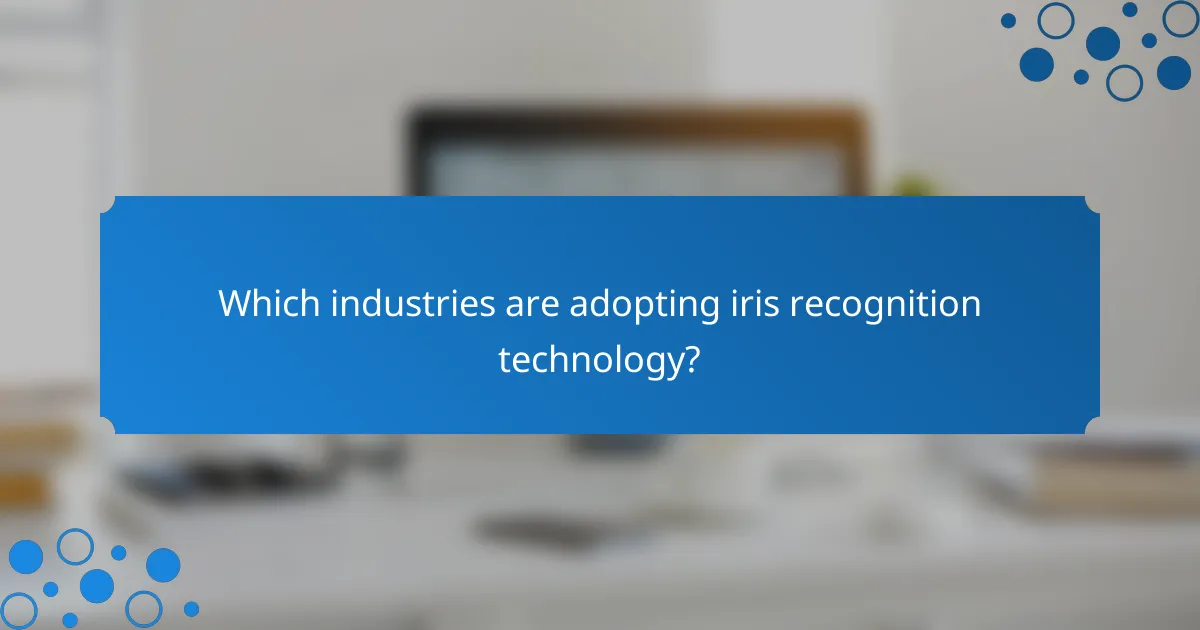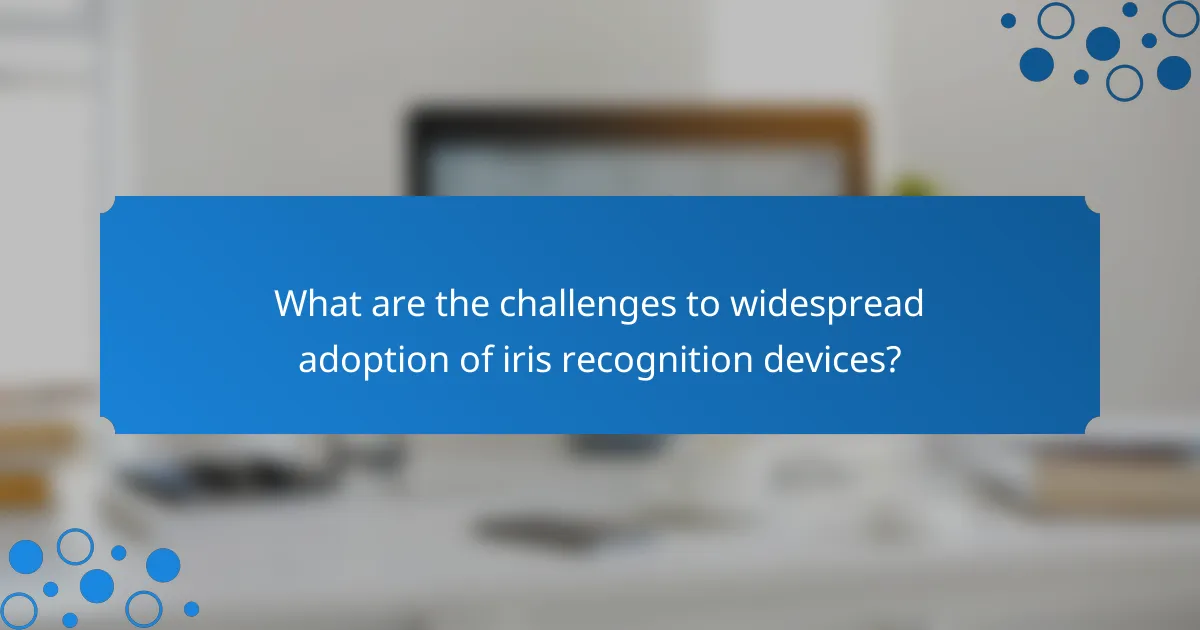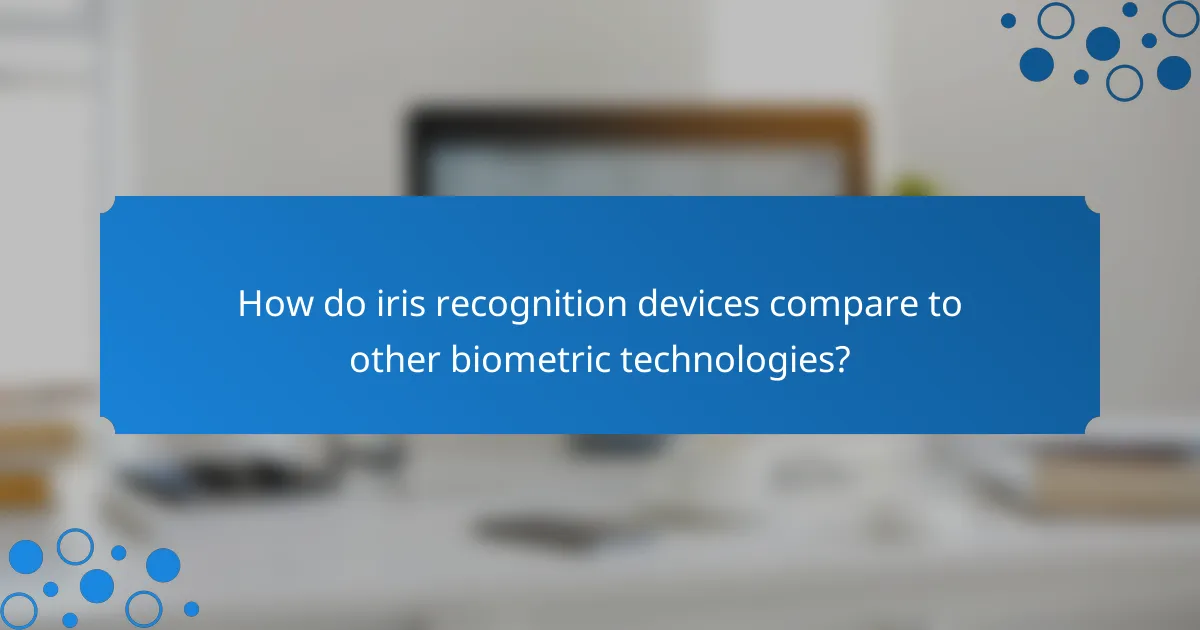Recent advancements in technology and reduced manufacturing costs have led to the miniaturization and affordability of iris recognition devices, making them more accessible to both businesses and consumers. As a result, these devices are gaining traction across various sectors, offering high accuracy and enhanced security for identity verification. Their growing popularity is transforming how organizations approach biometric security solutions.

How are iris recognition devices becoming more affordable in Canada?
Iris recognition devices are becoming more affordable in Canada due to several factors, including reduced manufacturing costs, advancements in technology, and increased competition among vendors. These changes are making it easier for businesses and consumers to access this biometric technology.
Reduced manufacturing costs
The manufacturing costs of iris recognition devices have significantly decreased as production techniques have improved. Automation and streamlined processes allow manufacturers to produce devices at a lower cost, which can be passed on to consumers. For instance, the price of components like cameras and sensors has dropped, contributing to overall affordability.
Additionally, bulk purchasing of materials and components can lead to further reductions in costs. As more companies enter the market, economies of scale become achievable, further driving down prices.
Advancements in technology
Recent advancements in technology have enhanced the efficiency and effectiveness of iris recognition systems. Innovations in image processing algorithms and hardware miniaturization have led to devices that are not only cheaper but also more reliable. For example, modern devices can capture high-quality iris images in less time, improving user experience.
Furthermore, the integration of iris recognition with other biometric systems, such as facial recognition, can reduce the overall cost of security solutions. This convergence allows for more versatile systems that meet various security needs without significantly increasing expenses.
Increased competition among vendors
The growing number of vendors in the iris recognition market has intensified competition, which typically drives prices down. As new players enter the field, they often introduce innovative features at competitive prices to attract customers. This competition encourages existing companies to lower their prices or enhance their offerings to maintain market share.
Consumers benefit from this competitive landscape, as they can choose from a wider range of products that fit different budgets. Additionally, vendors may offer financing options or subscription models, making it easier for businesses to adopt iris recognition technology without a substantial upfront investment.

What are the key benefits of iris recognition devices?
Iris recognition devices offer significant advantages, including high accuracy, enhanced security, and a fast identification process. These benefits contribute to their growing popularity in various sectors, from banking to personal security.
High accuracy and security
Iris recognition technology is known for its exceptional accuracy, often exceeding 99% in identifying individuals. This high level of precision stems from the unique patterns in each person’s iris, making it a reliable method for authentication.
The security provided by iris recognition is robust, as it is difficult to replicate or forge. Unlike passwords or even fingerprints, which can be compromised, the iris’s distinct characteristics provide a strong barrier against unauthorized access.
Fast identification process
The identification process with iris recognition devices is remarkably swift, typically taking only a few seconds. Users can be authenticated in low tens of milliseconds, allowing for quick access in high-traffic environments such as airports or banks.
This speed is particularly beneficial in scenarios where time is critical, as it minimizes wait times and enhances user experience. For instance, using iris recognition for boarding passes can streamline airport security checks significantly.
Non-invasive technology
Iris recognition is a non-invasive technology, meaning it does not require physical contact or invasive procedures. Users simply need to look into the device, making it comfortable and easy to use.
This non-invasive nature also reduces hygiene concerns, especially in public spaces where multiple users may interact with the same device. As a result, iris recognition can be a more appealing option compared to fingerprint scanners or other biometric systems that may raise health concerns.

Which industries are adopting iris recognition technology?
Various industries are increasingly adopting iris recognition technology due to its accuracy and security benefits. This biometric solution is particularly appealing for sectors that require stringent identity verification processes.
Healthcare sector
The healthcare sector is utilizing iris recognition for patient identification and access control to sensitive medical records. This technology helps reduce errors in patient data management and enhances security in hospitals and clinics.
For instance, hospitals can implement iris scanning at check-in points to ensure that the right patient receives the correct treatment. This method not only streamlines operations but also protects patient privacy and complies with regulations like HIPAA in the United States.
Banking and finance
In banking and finance, iris recognition is being integrated into ATMs and mobile banking applications to enhance security. This biometric method offers a higher level of protection against fraud compared to traditional PINs or passwords.
Financial institutions are increasingly adopting this technology to comply with regulations and to build customer trust. For example, some banks offer iris scanning as a secure method for account access, reducing the risk of unauthorized transactions.
Government and law enforcement
Government agencies and law enforcement are leveraging iris recognition for identity verification in various applications, including border control and criminal identification. This technology provides a reliable means of confirming identities quickly and accurately.
For example, many countries are implementing iris scanning at immigration checkpoints to enhance security and streamline the entry process. This adoption not only improves safety but also helps in maintaining accurate records of individuals entering and exiting the country.

What are the challenges to widespread adoption of iris recognition devices?
The widespread adoption of iris recognition devices faces several challenges, including privacy concerns, integration with existing systems, and public awareness and acceptance. These factors can hinder the implementation and acceptance of this biometric technology in various sectors.
Privacy concerns
Privacy concerns are a significant barrier to the adoption of iris recognition devices. Many individuals fear that their biometric data could be misused or inadequately protected, leading to unauthorized surveillance or identity theft. Ensuring robust data protection measures and transparent usage policies is crucial to alleviate these fears.
Regulations such as the General Data Protection Regulation (GDPR) in Europe impose strict guidelines on the collection and processing of personal data, including biometrics. Organizations must comply with these regulations to build trust and encourage acceptance among users.
Integration with existing systems
Integrating iris recognition devices into existing security and identification systems can be complex and costly. Organizations may need to upgrade their infrastructure, which can involve significant investment and time. Compatibility with current software and hardware is essential to ensure a smooth transition.
To facilitate integration, organizations should conduct thorough assessments of their current systems and identify potential challenges. Developing a phased implementation plan can help manage costs and minimize disruptions during the transition.
Public awareness and acceptance
Public awareness and acceptance of iris recognition technology are crucial for its widespread use. Many people may not fully understand how the technology works or its benefits, leading to skepticism and resistance. Educational campaigns can help demystify the technology and highlight its advantages, such as enhanced security and convenience.
Engaging with communities and stakeholders can foster a positive perception of iris recognition devices. Demonstrating successful use cases in various sectors, such as healthcare and banking, can also encourage broader acceptance and trust in this technology.

How do iris recognition devices compare to other biometric technologies?
Iris recognition devices offer unique advantages over other biometric technologies, primarily in terms of accuracy and security. They utilize the distinct patterns in the iris, making them less prone to false matches compared to alternatives like fingerprints or facial recognition.
Versus fingerprint recognition
Fingerprint recognition relies on the unique patterns of ridges and valleys on a person’s fingertips. While it is widely used and generally affordable, it can be affected by factors such as skin condition or dirt, leading to potential inaccuracies. Iris recognition, on the other hand, is less susceptible to environmental conditions and provides a higher level of security due to the complexity of iris patterns.
Additionally, iris recognition systems can operate at a distance, allowing for contactless identification, which is particularly beneficial in public spaces or during health crises. This feature enhances user convenience and safety compared to fingerprint scanners that require direct contact.
Versus facial recognition
Facial recognition technology analyzes facial features to identify individuals. While it offers quick identification and can be implemented through standard cameras, its accuracy can be compromised by changes in lighting, angles, or facial expressions. Iris recognition provides a more stable and reliable method, as iris patterns remain consistent regardless of these variables.
Moreover, iris recognition can be more secure in environments where facial recognition may be fooled by photographs or masks. This makes iris technology a preferred choice for high-security applications, such as border control or access to sensitive areas.
Versus voice recognition
Voice recognition systems identify individuals based on vocal characteristics, which can vary due to health, background noise, or emotional state. This variability can lead to higher error rates compared to iris recognition, which relies on the fixed patterns of the iris. As a result, iris recognition is often favored in security-sensitive environments where accuracy is paramount.
Furthermore, voice recognition can be susceptible to spoofing through recorded audio, while iris recognition offers a more robust defense against such tactics. For applications requiring high security, iris recognition stands out as a more reliable option compared to voice-based systems.

What are the prerequisites for implementing iris recognition systems?
Implementing iris recognition systems requires specific prerequisites, including suitable hardware, software, and user acceptance. Organizations must ensure they have the necessary technology and infrastructure to support these systems effectively.
Hardware Requirements
To implement iris recognition systems, high-quality cameras capable of capturing detailed images of the iris are essential. These cameras should operate under various lighting conditions and have a resolution that allows for accurate identification.
Additionally, processing units must be powerful enough to handle image processing and recognition algorithms efficiently. This often includes dedicated servers or cloud-based solutions that can manage data securely and swiftly.
Software Requirements
Robust software is crucial for iris recognition systems, encompassing image processing, feature extraction, and matching algorithms. The software should comply with industry standards for security and privacy, ensuring that sensitive biometric data is protected.
Integration capabilities with existing systems, such as access control or identity management platforms, are also important. This ensures seamless operation and enhances the overall user experience.
User Acceptance and Training
User acceptance is vital for the successful implementation of iris recognition systems. Organizations should educate users on the benefits and privacy aspects of using biometric technology to foster trust and acceptance.
Training sessions can help users become familiar with the technology, reducing resistance and ensuring smooth operation. Addressing common concerns about privacy and data security is essential to gain user confidence.
